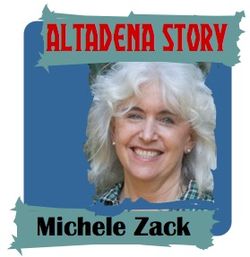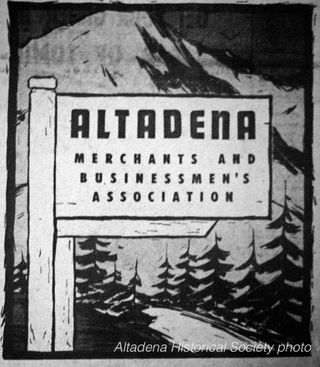The Altadena Town Council has set up an Altadena beautificaton committee -- an idea with a long past. Historian Michele Zack looks at the history -- and future -- of beautification in Altadena
by Michele Zack

 Meetings of the Altadena Historical and Beautification Society (established in 1935) were truly a mixed bag. One May morning in 1939 at the home of Mrs. Harry P. Gibson on Braeburn Avenue a scholarly talk on Pasadena founders Dr. Elliot and his consumptive land scout D.M.Berry was followed by a report from the Fountain Committee on the aesthetically pleasing watering hole at Lake and Mendocino it had erected earlier. Winding up the morning was a briefing on Adolf Hitler’s effective use of propaganda to expand into Eastern Europe in search of Lebensraum.
Meetings of the Altadena Historical and Beautification Society (established in 1935) were truly a mixed bag. One May morning in 1939 at the home of Mrs. Harry P. Gibson on Braeburn Avenue a scholarly talk on Pasadena founders Dr. Elliot and his consumptive land scout D.M.Berry was followed by a report from the Fountain Committee on the aesthetically pleasing watering hole at Lake and Mendocino it had erected earlier. Winding up the morning was a briefing on Adolf Hitler’s effective use of propaganda to expand into Eastern Europe in search of Lebensraum.
Society meeting reports in the Altadena section of the Star News noted talks by authors such as Charles Saunders on his new book The History of Early California Flowers and the reading by its letter to the Interior Secretary Harold Ickes in FDR’s administration protesting “Desert Plant Monument” as a name for our newest National Park. The Altadena group suggested the more evocative and specific “Joshua Tree National Monument.” It also voted to join “Opposition to Tree Slaughter,” a group or movement whose history might be lost, but whose spiritual descendants have certainly resurfaced over the years — a few years ago in Arcadia, for example.

The “Unsightly Lots Committee” chair reported that wild flower seeds had been obtained to plant in the town’s still many vacant lots, and members were active in educating citizens to avoid “unsightly business signs and other objects unsightly to the landscape.”
Amid all this political, aesthetic, and horticultural action, the group published the community’s first history, Altadena, written by member Sarah Noble Ives, in 1939. Ives, former journalist and an artist, threw herself into community improvement as soon as she and her sisters arrived in town in 1924. She dedicated her book with a rousing quote in Sanskrit that was a call to bring about “The Bliss of Growth, the Glory of Action, The Splendor of Beauty.”
Evolution of beautification
The ferment of the socially active, economically depressed 1930s gradually organized itself into distinct and discrete interest groups by the 1940s. The Society dropped “beautification” from its name and mission and became apolitical. Horticultural slack was taken up by other groups such as the Garden Club and the Forty Planters, a division of the Altadena Women’s Circle. Other activist groups came and went, and Altadena Heritage, originally a committee of the Town Council in the 1980s, emerged as a separate nonprofit that originally concentrated on activism in historic preservation, and more recently, in other civic and sustainability issues.
The latest version (2.0?) of a group intent on Altadena beautification arrived in 2011 when Altadena Town Council’s Chair Dr. Sandra Thomas asked me to lead a committee with this focus. She’s set up several committees, including a couple new ones, in the course of her chairmanship. Only when I began thinking about writing this article did I remember that history and beauty once co-mingled in a single society here. And that I, commissioned in 2001 by the Altadena Historical Society to write its second community history, was again walking in the footsteps of activist Sarah Nobles Ives with this latest beautification effort!
Our committee is nimble and well-rounded in terms of skills and interest: Town Council Member Greg Middleton, Jane Brackman, of Altadena Historical Society, Mark Goldschmidt and Eileen Alduenda of Altadena Heritage. The idea is that we will actively advocate for things that make Altadena more beautiful, gather up ideas and input from the community, and work with Supervisor Antonivich’s Field Representative Sussy Nemer and the Town Council to turn opportunities into beautiful realities.
More trees on Woodbury
The first project in which the committee became involved is the beautification of Woodbury Corridor, which presents a rare opportunity to improve and make beautiful the gateway to Altadena's Western portion. This could be a lovely parkway and boundary between Pasadena and Altadena, but it generally falls short, especially from Los Robles west to Windsor. Woodbury used to be narrower and more residential along its entire course, as it still is east of Santa Anita. But when it was widened into a parkway in the 1960s (around the same time Marengo was realigned to eliminate the jog at Woodbury), frontages were severely reduced so that houses lost front yards and found themselves directly on a busy street without any landscape mitigation to absorb the shock. Many residences transformed from owner occupied to rental units or changed to commercial/institutional use; this began a cycle of decay that coincided with other well-known social changes of the 1960s, including redevelopment and freeway building down in Pasadena, and upheavals caused by lawsuits over the integration of PUSD.
Finally, this summer Los Angeles County will make landscape improvements to the asphalt median it created 50 years ago, but which was never much improved. Along Woodbury many homeowners have recently made private improvements; added to these, the corridor will become more pleasant to live and to drive along when its median is planted with oak trees and other drought tolerant and native plantings. Decomposed granite will replace asphalt in wider areas, thus allowing increased infiltration of rainwater into underground sumps. A new bike lane will encourage this mode of travel.
Our Committee met with County, went over plans, and made a few planting recommendations. Two members, Mark Goldschmidt and Eileen Alduenda, are trained in landscape architecture. We had hoped for an entire street redesign that would also improve sidewalks and channel and infiltrate much more runoff into the median and the aquifer underneath Altadena — thus meeting the County’s own LID (low impact design) standards. Unfortunately this project (and budget) is limited to median landscaping and curbs only, and does not include redoing street levels to allow for north-side-of-the-median curb cuts that would channel runoff into the median and down into the earth. In this economy, however, any improvement is welcome.
Help blown in on the wind
Coincidentally, there was an ill wind that we hope will blow some good our way. The severe windstorm of Nov. 30-Dec. 1, 2011, took down many trees, and the County found money for a grant to replace some of these — but the money may also be used to plant new street trees. We saw the notice of this in the newspaper and immediately applied. We will find out at the end of this month if, in addition to our new median tree- and landscaping, we will get a few hundred new street trees planted along Woodbury from Santa Anita to Windsor. The positive impact of landscaping both the middle and street sides of Woodbury will be significant. In addition, the now nicely grown in pocket park at Marengo and Woodbury, a project of Altadena Foothills Conservancy (now Arroyos and Foothills Conservancy) Altadena Heritage, and Los Angeles County, adds interest and beauty to the corridor.
The second project of the Beautification Committee commenced when Dr. Sandy called a couple months ago, and asked if our committee would also investigate new signage to announce to people that they had, indeed, entered Altadena. Creating a series of customized “welcomes” to help brand our unique community with something other than standard issue LA County and other commercially available signs is another rare opportunity. After a few of us made Internet searches for ideas that yielded nothing very inspiring, we thought to ask Jane Brackman, of Altadena Historical Society for help.

Jane immediately came up a very cool sign from the 1930s or 40s that might be modified to work for us today. We will be able to place several such upright signs at entry points to town, as well as a few larger monument signs, on the Woodbury Corridor, and on New York Drive just east of Altadena Drive on the median recently improved by Pasadena with drought tolerant plantings, decomposed granite, and arroyo stones. Our Committee will work with the County and the Town Council on this project, and we welcome public input as well.
Looking to the community
What do you think of adaptively reusing the older, upright sign? Its elemental composition of mountains and deodars still works, but obviously we would need to take out the Merchants Association and make “Altadena” much bigger. Do you have another idea? Please submit designs or proposals to our Committee, or leave comments on the Blog. We are also considering designs for monument signs, which should go with the oak, droughty vegetation, and decomposed granite look of both the Woodbury and New York Drive Medians.
We look forward to hearing from community members on the above as well as other areas of Altadena in need of beauty treatment. We have no budget, and so are relying on volunteers and other opportunities to pounce upon, such as the tree grant, as well as working with the County to provide input on projects already being considered.
As a writer who spends a lot of time in the past, I am naturally attracted to highlighting and using historic resources available to us. Our committee, however, is not stuck in the past and wishes to explore as many ways as possible for Altadena to move closer to living up to its many beautiful potentials. As Sarah Nobel Ives pointed out in the poem on the Altadena’s cover page, “Yesterday is but a dream. . . . Look well therefore to this Day. . . [to realize] The Splendor of Beauty.”



